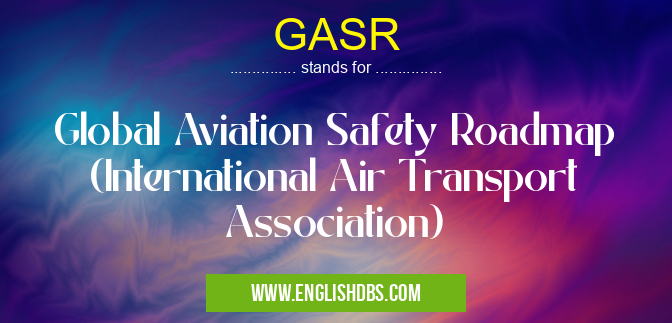What does GASR mean in AIRCRAFT & AVIATION
The Global Aviation Safety Roadmap (GASR) is an initiative created by the International Air Transport Association (IATA) that promotes the global advancement of aviation safety. This roadmap acts as a comprehensive guide to drive the industry towards achieving safer skies through effective implementation of safety measures and international cooperation. The GASR includes recommended changes to operational, regulatory and other issues such as training, maintenance and airfield management in order to achieve the highest levels of aircraft safety.

GASR meaning in Aircraft & Aviation in Miscellaneous
GASR mostly used in an acronym Aircraft & Aviation in Category Miscellaneous that means Global Aviation Safety Roadmap (International Air Transport Association)
Shorthand: GASR,
Full Form: Global Aviation Safety Roadmap (International Air Transport Association)
For more information of "Global Aviation Safety Roadmap (International Air Transport Association)", see the section below.
Benefits of GASR
The advancement of aviation safety requires global collaboration between countries and their respective government agencies responsible for civil aviation. One significant benefit of using GASR is its ability to provide a unified approach towards assessing risk factors and reducing accident rates among various nations. Additionally, it provides up-to-date information on industry trends in order to keep airlines well informed on potential hazards or risks that may affect their operations. Finally, GASR facilitates communication between all related entities which increases efficiency when collaborating with stakeholders on implementing new rules or procedures that aim at improving overall aviation safety standards worldwide.
Essential Questions and Answers on Global Aviation Safety Roadmap (International Air Transport Association) in "MISCELLANEOUS»AIRCRAFT"
What is the Global Aviation Safety Roadmap?
The Global Aviation Safety Roadmap (GASR) is a plan developed by the International Air Transport Association (IATA) to improve global aviation safety. It provides direction and structure to enable IATA's members, together with other industry stakeholders, to achieve this goal.
How does the GASR help to promote safe air travel?
The GASR helps to promote safe air travel by setting an agenda for consistent and comprehensive improvements in aviation safety worldwide. This includes addressing key areas such as accident prevention, regulatory compliance and implementing technological advancements in the industry.
What are the main objectives of the Global Aviation Safety Roadmap?
The main objectives of the Global Aviation Safety Roadmap are to support improved safety standards throughout the aviation sector, reduce accidents and fatalities to historically low levels, ensure compliance with regulations across jurisdictions and eliminate problems associated with aircraft operations.
Who is responsible for implementing GASR performance targets?
The responsibility for implementation of GASR performance targets lies with all stakeholders involved in air transport including airlines, airports, manufacturers, industry authorities and regulators. Each stakeholder has their own role in achieving these goals which they must work together to accomplish.
What are some of the key initiatives outlined by GASR?
Some key initiatives outlined by GASR include improving flight data monitoring systems, enhancing airport security procedures and infrastructure, ensuring uniform training standards among personnel involved in aircraft operation and maintenance activities, standardized international guidelines on aircraft maintenance repairs as well as research into innovative technologies that could contribute significantly towards improved aviation safety globally.
How often does IATA review its Global Aviation Safety Roadmap?
IATA reviews its Global Aviation Safety Roadmap annually in order to keep up with changing trends within the industry such as new technologies or evolving regulations. This review allows for adjustments to be made in order for IATA to continue striving towards its goal of improved global aviation safety standards for all who rely upon it.
Does GASR consider other factors beyond aviation technology?
Yes, GASR considers other factors beyond technology such as human behaviour or weather conditions that all have a role when it comes to safe air travel operations. These additional considerations are designed to bring a comprehensive approach that covers all aspects related to ensuring optimal operational safety within the aviation sector.
Are there any specific benefits of having a unified roadmap like GASR?
One benefit of having a unified roadmap like GASR is increased visibility into how different stakeholders must work cooperatively together towards common goals while also allowing each one align their respective agenda's thus ensuring success through coordinated plans and actions.
How can better collaboration between industry participants enhance effectiveness of efforts taken under the framework of GASR?
Better collaboration between industry participants elevates everyone's understanding about policies or procedures related directly or indirectly with their operations giving them better context when comes suitable requirements from local authorities or making decisions around investments on technological enhancements or specialized training.
Final Words:
The Global Aviation Safety Roadmap (GASR) serves as a valuable resource for international stakeholders in the civil aviation sector by providing guidance on how best practices can be applied across all levels within an organization and yet remain compliant with global flight regulations. By actively engaging all parties involved in this process — including manufacturers, operators, airports, services providers and more — enhanced quality control will be achieved through collaborative effort ultimately resulting in improved aircraft reliability globally.
GASR also stands for: |
|
| All stands for GASR |
